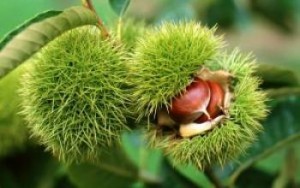by Tim Dorsey
Recently I had the chance to intervene and save what might be an extremely rare specimen of an almost completely decimated population. It wasn’t due to my forethought or activism, but a case of extremely fortuitous timing.
My wife and I had just moved into our new house and our next-door neighbor was casually mentioning that his other-side neighbor was going to have her chestnut tree cut down over the coming weekend and he was going to salvage it for firewood. Apparently, the falling burrs (which contain the nuts) had become a nuisance to our neighbor each autumn when they fall.
My first thought was indeed to protest and try to save the tree—but not for what would prove to be the most important reason. I was excited about the nuts as a source of locally available protein and deliciousness, and proposed to take over the duties of collecting them when they fell, and not-so-urgently asked my next-door neighbor to pass on the offer.
The very next day I was giving a tour of the CUE Farm to several visiting students on Butler’s campus for an undergraduate research conference. Two of them happened to mention work they were working with one of their professors at Hanover College to breed a strain of chestnut tree resistant to blight. Immediately I recalled that chestnut trees had been severely affected by disease over the last century. I noted the unbelievable timing and mentioned that my neighbor was planning to have one cut down and was met with a collective ghastly outcry! They insisted I needed to make sure, but that there was a 99% chance that the tree in question was the entirely different species Horse chestnut, which folks also commonly refer to as “chestnut”.
As it happens, the once mighty American chestnut—comprising perhaps 25% of our Eastern forests—had been decimated by chestnut blight introduced in the early 20th century following its introduction through the importation of an Asian chestnut species. The American chestnut just hadn’t developed a resistance to the disease. Over the course of a few decades nearly all the American chestnuts in its native range were killed, and by some estimates there may be less than 100 specimens remaining (out of perhaps 3 billion!) at a diameter of 24 inches. [The species is not extinct in the native range, even other than the handful of larger specimens left, due to the fact that the stumps of the killed trees continue to send up sprouts, but these never reach reproductive age before succumbing to blight.] The chestnuts sold around the Holidays are usually from a European cousin or possibly from successfully grown American chestnuts grown out West where the organism responsible for the blight doesn’t survive.
I did in fact confirm from an old fallen burr and some fallen leaves that this was indeed an American chestnut. How or why it has survived is unknown but it may be valuable in breeding efforts due to the fact that it obviously has shown resistance to the blight. I feel privileged to live in its neighborhood! And I’m still looking forward to collecting those “nuisance” nuts in the fall.
Tim Dorsey is the CUE Farm manager.

